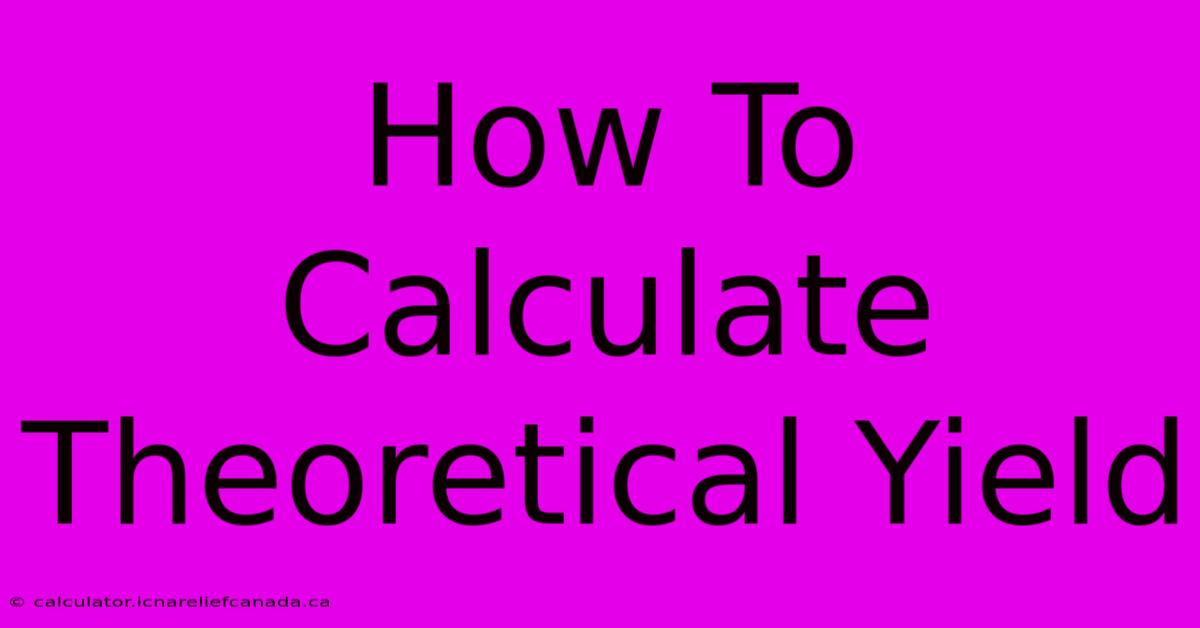How To Calculate Theoretical Yield

Table of Contents
How to Calculate Theoretical Yield: A Comprehensive Guide
Understanding theoretical yield is crucial in chemistry and related fields. It represents the maximum amount of product that can be formed from a given amount of reactant, assuming the reaction proceeds perfectly with 100% efficiency. This calculation is vital for predicting reaction outcomes and optimizing experimental procedures. This guide will walk you through the process of calculating theoretical yield step-by-step.
Understanding the Fundamentals
Before diving into calculations, let's clarify some key terms:
- Reactants: The starting materials in a chemical reaction.
- Products: The substances formed as a result of the chemical reaction.
- Stoichiometry: The quantitative relationship between reactants and products in a chemical reaction, expressed through balanced chemical equations.
- Molar Mass: The mass of one mole of a substance, expressed in grams per mole (g/mol).
- Limiting Reactant: The reactant that is completely consumed first in a reaction, thus limiting the amount of product that can be formed.
Step-by-Step Guide to Calculating Theoretical Yield
Calculating theoretical yield involves several steps:
1. Write and Balance the Chemical Equation:
This is the foundation of the calculation. Ensure the equation accurately represents the reaction and is balanced, meaning the number of atoms of each element is equal on both sides of the equation. For example:
2H₂ + O₂ → 2H₂O
This equation shows that 2 moles of hydrogen (H₂) react with 1 mole of oxygen (O₂) to produce 2 moles of water (H₂O).
2. Determine the Moles of Each Reactant:
Use the given mass of each reactant and its molar mass to calculate the number of moles. The formula is:
Moles = Mass (g) / Molar Mass (g/mol)
3. Identify the Limiting Reactant:
Compare the mole ratios of the reactants to the stoichiometric ratios in the balanced equation. The reactant with the smallest mole ratio (compared to its stoichiometric coefficient) is the limiting reactant. This reactant will determine the maximum amount of product that can be formed.
4. Calculate the Moles of Product:
Use the stoichiometric ratio from the balanced equation and the moles of the limiting reactant to determine the moles of the product that will be formed.
5. Calculate the Theoretical Yield:
Finally, convert the moles of the product to grams using its molar mass:
Mass (g) = Moles × Molar Mass (g/mol)
This mass represents the theoretical yield – the maximum amount of product expected if the reaction proceeds perfectly.
Example Calculation
Let's calculate the theoretical yield of water (H₂O) formed from the reaction of 4 grams of hydrogen (H₂) and 32 grams of oxygen (O₂).
-
Balanced Equation: 2H₂ + O₂ → 2H₂O
-
Moles of Reactants:
- Moles of H₂ = 4 g / (2 g/mol) = 2 moles
- Moles of O₂ = 32 g / (32 g/mol) = 1 mole
-
Limiting Reactant:
- The mole ratio of H₂ to O₂ is 2:1, which matches the stoichiometric ratio. Therefore, neither reactant is limiting in this specific example.
-
Moles of Product:
- Since we have 2 moles of H₂, and the stoichiometry shows 2 moles of H₂ producing 2 moles of H₂O, we'll produce 2 moles of H₂O.
-
Theoretical Yield:
- Mass of H₂O = 2 moles × (18 g/mol) = 36 g
Therefore, the theoretical yield of water is 36 grams.
Factors Affecting Actual Yield
It's important to remember that the theoretical yield is a theoretical maximum. The actual yield obtained in an experiment is often lower due to various factors, including:
- Incomplete Reactions: Not all reactants may react completely.
- Side Reactions: Unwanted reactions may occur, consuming reactants and reducing the yield of the desired product.
- Loss of Product: Some product may be lost during the experiment, such as during filtration or transfer.
The percentage yield, calculated by comparing the actual yield to the theoretical yield, provides a measure of the efficiency of the reaction.
Conclusion
Calculating theoretical yield is a fundamental skill in chemistry. Mastering this process provides a valuable tool for understanding and predicting reaction outcomes, optimizing experimental designs, and assessing reaction efficiency. Remember to always start with a balanced chemical equation and carefully consider the limiting reactant. By following these steps, you can accurately determine the theoretical yield of any chemical reaction.

Thank you for visiting our website wich cover about How To Calculate Theoretical Yield. We hope the information provided has been useful to you. Feel free to contact us if you have any questions or need further assistance. See you next time and dont miss to bookmark.
Featured Posts
-
How To Ungroup Cliops Sony Vegfas
Feb 05, 2025
-
How To Pronounce Cicatelli
Feb 05, 2025
-
How To Get To Messmer
Feb 05, 2025
-
Jordans Son Faces Drug Charges In Florida
Feb 05, 2025
-
Senate To Vote On Rfk Jr Hhs Post
Feb 05, 2025
